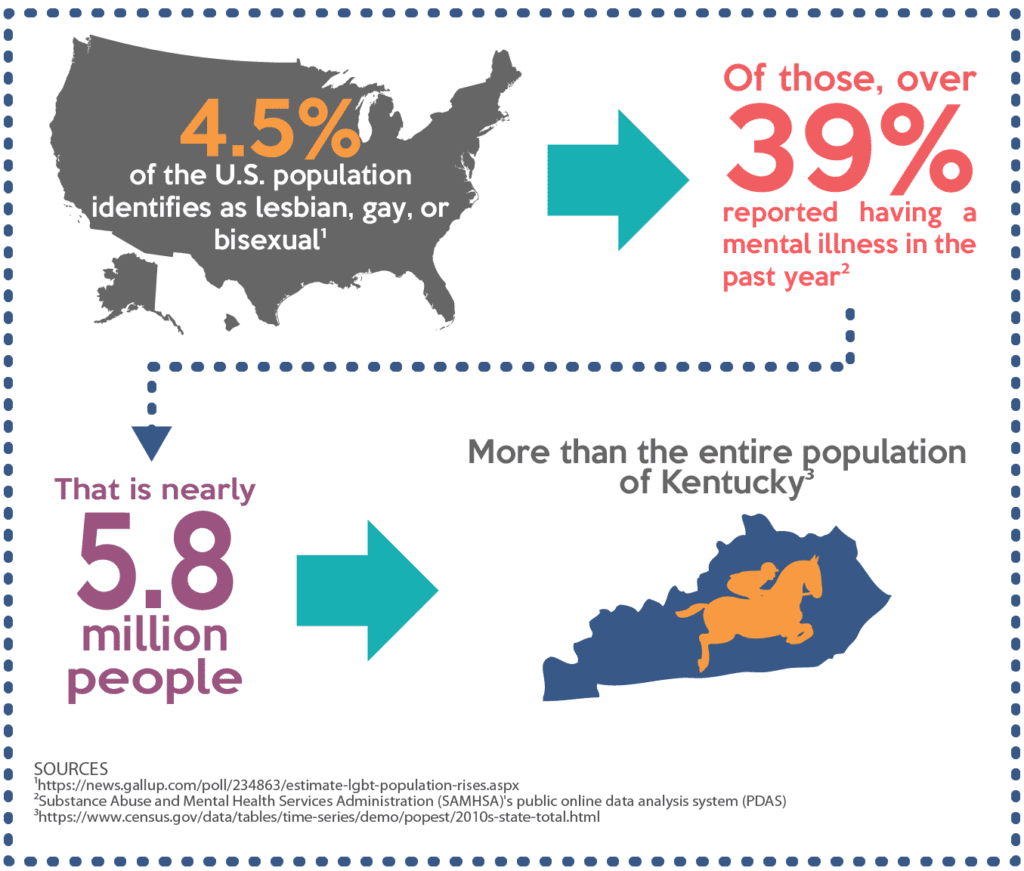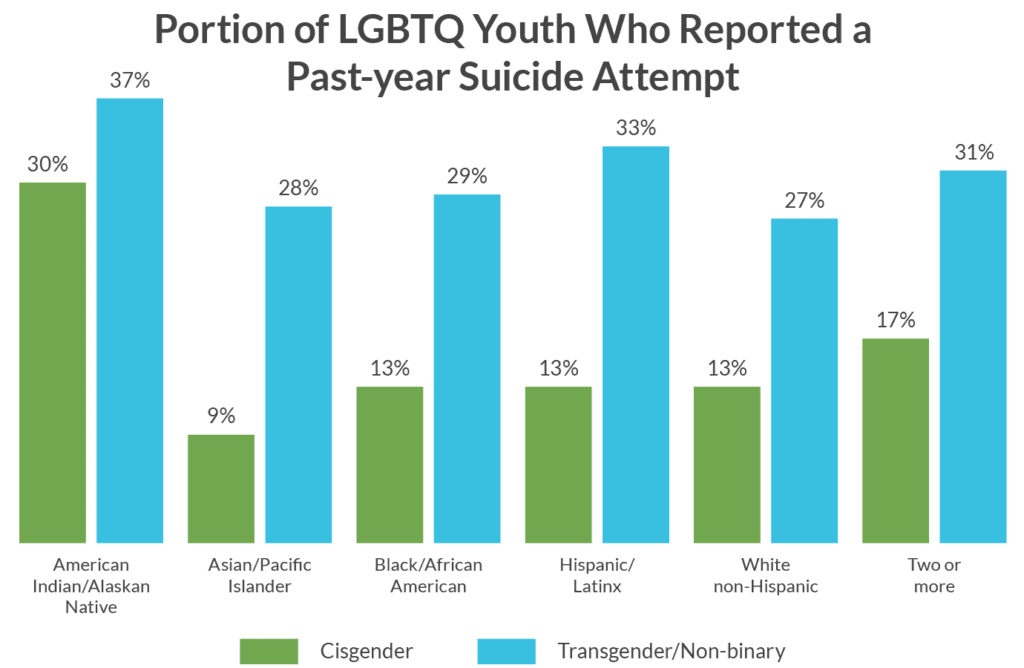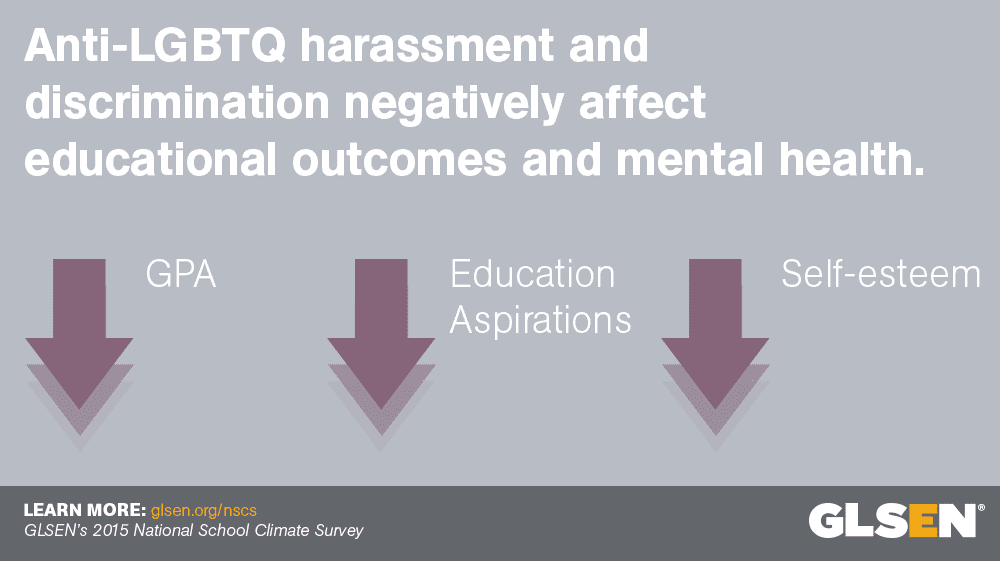Mental Health Is More Than Suicide Prevention
Many factors can lead a person to suicide.
- LGBTQ youth are not inherently prone to suicide risk because of their sexual orientation or gender identity but rather placed at higher risk because of how they are mistreated and stigmatized in society.
- Research has found multiple factors associated with suicidal behavior among LGBTQ people, including isolation from family and peers, a history of mental health issues (e.g., depression and anxiety), substance use disorders, and victimization (e.g., being the target of bullying; being abused).
- The Trevor Project estimates that more than 1.8 million LGBTQ youth (13-24) seriously consider suicide each year in the U.S. — and at least one attempts suicide every 45 seconds.


Suicide Statistics within the LGBTQ+ Community
- Suicide is the 2nd leading cause of death among young people ages 10 to 24.
- LGBT youth seriously contemplate suicide at almost three times the rate of heterosexual youth.
- LGBT youth are almost five times as likely to have attempted suicide compared to heterosexual youth.
- Of all the suicide attempts made by youth, LGBT youth suicide attempts were almost five times as likely to require medical treatment than those of heterosexual youth.
- Suicide attempts by LGBT youth and questioning youth are 4 to 6 times more likely to result in injury, poisoning, or overdose that requires treatment from a doctor or nurse, compared to their straight peers.
- In a national study, 40% of transgender adults reported having made a suicide attempt. 92% of these individuals reported having attempted suicide before the age of 25.
- LGBT youth who come from highly rejecting families are 8.4 times as likely to have attempted suicide as LGBT peers who reported no or low levels of family rejection.
- 1 out of 6 students nationwide (grades 9–12) seriously considered suicide in the past year.
- Each episode of LGBT victimization, such as physical or verbal harassment or abuse, increases the likelihood of self-harming behavior by 2.5 times on average.
LGBTQ+ Youth and Bullying
LGBT teens have to deal with harassment, threats, and physical and emotional violence directed at them on a daily basis. LGBT youth are nearly twice as likely to be called names, verbally harassed or physically assaulted at school compared to their non-LGBT peers. [1]
How is their mental health being affected?
- Substance Use: Gay, lesbian, bisexual and transgender youth are more than twice as likely to experiment with drugs and alcohol.
- Happiness: Only 37% of LGBT youth report being happy, while 67% of non-LGBT youth say they are happy. However, over 80% of LGBT youth believe they will be happy eventually, with nearly half believing that they will need to move away from their current town to find happiness.
- Self-Harm: With each instance of verbal or physical harassment, the risk of self-harm among LGBT youth is 2 ½ times more likely.
- Suicide: Gay, lesbian, and bisexual youth are 4 times more likely to attempt suicide than their heterosexual counterparts.
- Gay teens in U.S. schools are often subjected to such intense bullying that they’re unable to receive an adequate education. LGBT youth identified bullying problems as the second most important problem in their lives, after non-accepting families, compared to non-LGBT youth identifying classes/exams/grades.
- LGBT youth who reported they were frequently harassed in school had lower grade point averages than students who were less often harassed.
- One survey revealed that more than one-third of gay respondents had missed an entire day of school in the past month because they felt unsafe there.
- LGBT youth feel they have nowhere to turn. Sixty percent of LGBT students did not report incidents to school staff. One-third who reported an incident said the staff did nothing in response.


Help end bullying at your school with the following actions
- Be alert to signs of distress.
- Work with student councils to have programs on respect, school safety and anti-bullying.
- Ask school personnel to have a discussion at an assembly or an after-school activity about gay prejudice.
- Help start a Gay, Lesbian and Straight Education Network (GLSEN) chapter at your local high school.
- Arrange for a group like GLSEN to present bullying prevention activities and programs at your school.
- Do encourage anyone who’s being bullied to tell a teacher, counselor, coach, nurse, or his or her parents or guardians. If the bullying continues, report it yourself.
